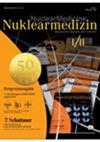甲状腺髓样癌在镓-68- psma - pet /CT上表现为偶发瘤-系统文献回顾和病例报告。
IF 1
4区 医学
Q4 RADIOLOGY, NUCLEAR MEDICINE & MEDICAL IMAGING
引用次数: 1
摘要
本文章由计算机程序翻译,如有差异,请以英文原文为准。
Medullary Thyroid Carcinoma presenting as an Incidentaloma on Gallium-68-PSMA-PET/CT - Systematic Literature Review and Case Report.
The prostate-specific membrane antigen (PSMA) is established in imaging and treatment of prostate cancer, especially in recurrent disease. PSMA is a membranebound glycoprotein with the function of a glutamic acid releasing carboxypeptidase enzyme, which is biologically expressed by the prostate and among others, proximal renal tubule cells, small intestine, central and peripheral nervous system [1]. Positrone Emission Tomography (PET)/ Computed Tomography (CT) imaging with Gallium (Ga)-68 in prostate cancer has its benefits in demonstrating the extent of the current disease and in preceding possible therapy with radionuclides like Lutetium (Lu)-177 and also the feasibility of intraoperative probe-assisted detection and localization of respective lesions. Numerous immunohistochemical studies have shown that PSMA is also upregulated on the endothelial cells of the neovasculature of a diverse group of other solid tumors. PSMA appears to promote endothelial invasion cell proliferation through its regulation of lytic proteases that can cleave the extracellular matrix [2]. PSMA expression in the neovasculature of tumors was likewise shown for example in renal cell carcinoma, rectal carcinoma, lung cancer, hepatocellular carcinoma, lymphoma, urinary bladder, stomach, small intestine and differentiated thyroid cancer [3, 4, 5, 6, 7, 8, 9, 10, 11, 12, 13, 14]. Heitkötter et al discussed that in thyroid carcinomas, PSMA expression was more common in poorly differentiated species [15]. Poorly differentiated tumors grow rapidly, resulting in intratumoral hypoxemia, in which PSMA supports neovascularization. It is therefore not surprising that several studies have demonstrated an association between high PSMA expression and poorer prognosis and outcome. Haffner et al. were able to demonstrate this association in squamous cell carcinoma of the oral cavity, Jiao et al. in hepatocellular carcinoma and Sollini et al. in differentiated thyroid cancer [16, 17, 18].
求助全文
通过发布文献求助,成功后即可免费获取论文全文。
去求助
来源期刊
CiteScore
1.70
自引率
13.30%
发文量
267
审稿时长
>12 weeks
期刊介绍:
Als Standes- und Fachorgan (Organ von Deutscher Gesellschaft für Nuklearmedizin (DGN), Österreichischer Gesellschaft für Nuklearmedizin und Molekulare Bildgebung (ÖGN), Schweizerischer Gesellschaft für Nuklearmedizin (SGNM, SSNM)) von hohem wissenschaftlichen Anspruch befasst sich die CME-zertifizierte Nuklearmedizin/ NuclearMedicine mit Diagnostik und Therapie in der Nuklearmedizin und dem Strahlenschutz: Originalien, Übersichtsarbeiten, Referate und Kongressberichte stellen aktuelle Themen der Diagnose und Therapie dar.
Ausführliche Berichte aus den DGN-Arbeitskreisen, Nachrichten aus Forschung und Industrie sowie Beschreibungen innovativer technischer Geräte, Einrichtungen und Systeme runden das Konzept ab.
Die Abstracts der Jahrestagungen dreier europäischer Fachgesellschaften sind Bestandteil der Kongressausgaben.
Nuklearmedizin erscheint regelmäßig mit sechs Ausgaben pro Jahr und richtet sich vor allem an Nuklearmediziner, Radiologen, Strahlentherapeuten, Medizinphysiker und Radiopharmazeuten.

 求助内容:
求助内容: 应助结果提醒方式:
应助结果提醒方式:


